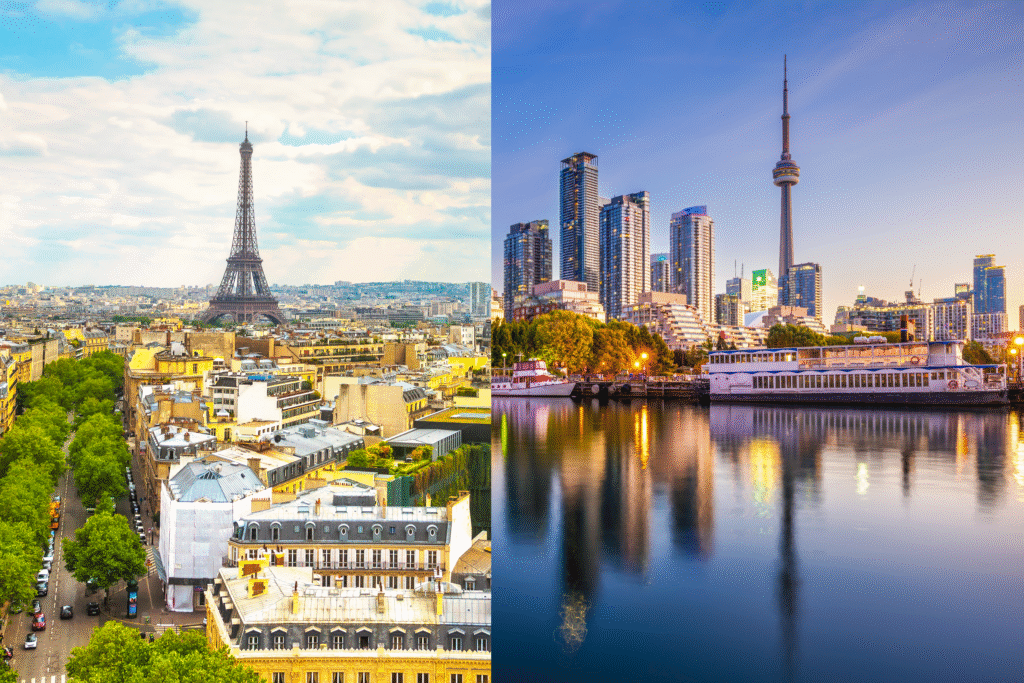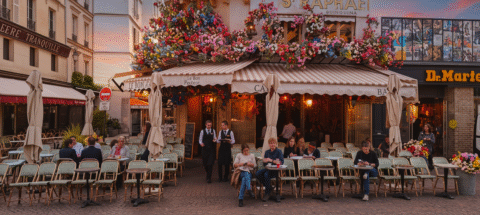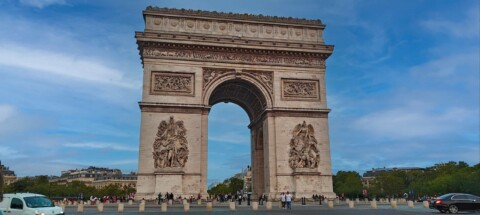When you think of Paris, you probably picture the Eiffel Tower, berets, and people who could make a grocery list sound like poetry. When you think of Toronto, you might envision a diverse metropolis, apologetic hockey fans, and people who pronounce “about” in a way that makes Americans giggle. On the surface, these two cities seem about as similar as croissants and poutine (both delicious, completely different contexts).
But here’s the thing: scratch beneath the surface of these two beloved cities, and you’ll find they’re basically separated-at-birth siblings who took very different fashion paths. One went full haute couture, the other embraced practical fleece, but they share the same DNA. Let me explain.
The “We’re Actually Multiple Cities Pretending to Be One” Vibe
Paris isn’t just Paris—it’s twenty arrondissements spiraling out from the center like a snail shell (yes, they went with a snail pattern, très français). Each arrondissement has its own personality, its own vibe, its own preferred type of pretension. The Marais is artsy and historic, the 16th is posh and proper, and the 18th gives you Montmartre’s bohemian energy mixed with Barbès’ multicultural hustle.
Toronto? Same energy, different accent. We’ve got distinct neighborhoods that might as well be their own cities. Kensington Market is our quirky, artsy answer to the Marais. Rosedale channels serious 16th arrondissement wealth vibes (old money, big houses, quiet streets). Queen West has that cool, creative Montmartre spirit, while neighborhoods like Little Portugal, Greektown, Little India, and Chinatown create their own distinct worlds within the city.
Both cities are essentially collections of micro-cities that agreed to share a municipal government and pretend they get along. Spoiler: they don’t always, but that’s what makes them interesting.
Food Snobbery (Affectionate)
Let’s address the elephant—or should I say, the escargot—in the room. Paris is famous for its food culture. Parisians take their bread so seriously that there are actual laws about what can be called a baguette. They have lunch debates that would put political roundtables to shame. Cheese isn’t just food; it’s a way of life, a philosophy, possibly a religion.
“But Toronto doesn’t have that!” you say. Oh, my sweet summer child. Have you met a Torontonian discussing the “best” ramen spot? The proper way to eat a peameal bacon sandwich? Which patty shop makes the most authentic Jamaican beef patty? Don’t even get them started on dim sum, shawarma, or where to find “authentic” tacos.
Toronto’s food snobbery is democratic—we’re snobby about EVERYONE’S cuisine. We don’t just gatekeep French food; we gatekeep Portuguese, Korean, Italian, Ethiopian, and about eighty other food traditions. We’re equal-opportunity food snobs, which, when you think about it, is actually kind of beautiful.
Both cities are filled with people who will walk an extra twenty minutes to get to the “right” bakery, who have strong opinions about coffee, and who consider a good meal not just sustenance but an experience. The main difference? In Paris, they judge you for eating at the wrong time. In Toronto, we judge you for going to the wrong location of a chain that has thirty-seven identical outlets.
Transit Drama: When Your Relationship with Public Transportation Is Complicated
Ah, the Paris Métro. Ancient, labyrinthine, occasionally smelly, absolutely essential, and somehow still charming despite being over 120 years old. Parisians complain about it constantly while also being unable to imagine life without it. It’s the transit equivalent of a long marriage—you bicker, but you’re committed.
The TTC (Toronto Transit Commission) is like the Métro’s younger, scrappier cousin. Torontonians have an intensely emotional relationship with it. We complain about delays, we create memes about streetcars, we have feelings about particular subway lines. The TTC has its own personality—sometimes frustrating, often reliable enough, definitely character-building.
Both cities have residents who navigate their transit systems with the confidence of people who’ve memorized every connection, know exactly where to stand on the platform, and can calculate transfer times in their sleep. Both cities also have tourists standing confused in front of transit maps, looking like they’re trying to decode ancient hieroglyphics.
And here’s the real similarity: in both cities, suggesting someone actually use their car to drive downtown is met with looks of horror and pity. “Why would you do that to yourself?” they ask, genuinely concerned for your wellbeing.
The “We’re International, Darling” Complex
Paris has long held the title of international city. It’s the City of Light, the cultural capital of… well, France will tell you it’s the cultural capital of everything. People from around the world flock there to study, work, and dramatically consume coffee while contemplating existence.
Toronto has entered the chat. More than half of Toronto’s population was born outside Canada. We speak over 180 languages here. You can take a short subway ride and travel through culinary continents. Toronto’s diversity isn’t just a demographic fact; it’s the city’s entire personality.
Both cities have this beautiful, chaotic energy that comes from being genuinely international. You’re equally likely to overhear conversations in Mandarin, Arabic, Spanish, or Portuguese on a Toronto subway as you are to hear multiple languages on a Paris Métro. Both cities are places where the world comes together, argues about the best way to make a thing, and then creates something entirely new.
The difference? Paris has centuries of being a global crossroads and will remind you of this often. Toronto is still somewhat surprised by its own international status, like a kid who suddenly grew six inches and doesn’t quite know what to do with these long limbs yet.
Weather: A Shared Love of Complaining
Parisians love to complain about the weather. Too hot in summer (nevermind that “hot” means like 28°C), too cold in winter, too rainy in spring, too unpredictable in fall. The weather is wrong and someone should fix it.
Toronto? We have a Ph.D. in weather complaints. Our weather is genuinely unhinged—we can experience all four seasons in a single week, sometimes in a single day. We’ve had snow in April and t-shirt weather in February. Our weather forecast should just say “¯\(ツ)/¯” and call it a day.
But here’s what’s similar: in both cities, the weather is a reliable conversation starter, a shared enemy, and somehow also a point of pride. Parisians bond over suffering through gray winters together. Torontonians bond over surviving actual arctic conditions and then complaining about the scorching, humid summers.
Both cities also have residents who dress incorrectly for the weather out of sheer stubbornness. In Paris, they’ll be chic but cold. In Toronto, we’ll insist we don’t need a jacket yet and then regret everything.
Café Culture vs. Coffee Shop Culture
Paris invented sitting in cafés, people-watching, and making a single espresso last three hours. Café culture is integral to Parisian life—it’s where deals are made, novels are written, and existential crises are had in public.
Toronto didn’t invent coffee shop culture, but we’ve certainly embraced it with the enthusiasm of a golden retriever discovering a tennis ball. We have cafés on every corner. We have indie coffee shops with names like “Ethically Sourced Bean Dreams” where the baristas have strong opinions about extraction times. We have people working remotely from coffee shops who’ve been nursing the same oat milk latte for four hours.
The vibe is different—Parisians at cafés are being Parisian, soaking in the atmosphere. Torontonians at coffee shops are frantically typing away on laptops, trying to finish that project before the Wi-Fi times out. But both cities have created cultures where coffee establishments are third spaces, community hubs, and places where you can be alone together with strangers.
Architecture: Old Money vs. New Money (and Also Some Old Money)
Paris is a living architecture museum. Haussmann boulevards, Gothic churches, Belle Époque buildings—the city is gorgeous and knows it. The architecture tells stories of centuries of history, power, and really good urban planning in the 1800s.
Toronto’s architecture is… eclectic. We have beautiful Victorian homes next to brutalist concrete buildings next to glass condos that look like they’re from the future. We have historic buildings that we’ve preserved (some of them) and modern towers that sprout up like mushrooms after rain. It’s not always cohesive, but it’s interesting.
Here’s the similarity: both cities are constantly arguing about what to preserve and what to tear down. Paris fights about every modern addition (remember when the Eiffel Tower was considered an eyesore?). Toronto fights about development and heritage protection constantly. Both cities are trying to honor their past while building their future, and nobody can agree on how to do that.
Also, both cities have insane real estate prices that make owning property feel like a distant fantasy for anyone under 40. That’s a similarity nobody asked for, but here we are.
The Arts Scene: Pretentious? Us? Never.
Paris is THE art city. The Louvre, Musée d’Orsay, Centre Pompidou—it’s art history headquarters. The art scene is established, classical, and yes, sometimes pretentious in that particularly French way where even the pretension has layers of meaning.
Toronto’s arts scene is younger, scrappier, and trying really hard to prove itself. We have the AGO, the ROM, TIFF (Toronto International Film Festival, which is genuinely a big deal), and a thriving theater scene. Our contemporary art scene is vibrant and increasingly recognized internationally.
Both cities have art snobs who will debate movements and meaning over drinks. Both cities have emerging artists struggling to afford rent while creating the culture that makes the city interesting. Both cities understand that art isn’t just entertainment—it’s essential to the city’s identity.
The main difference is confidence level. Paris knows it’s an art capital and has known for centuries. Toronto is pretty sure it’s an art capital but will still get a bit excited when international publications say something nice about us.
Parks: Because Sometimes You Need to Pretend You’re Not in a Dense Urban Environment
Paris has its lovely parks and gardens—Luxembourg Gardens, Tuileries, Parc des Buttes-Chaumont. These are places where Parisians go to read, sunbathe (often topless, because they can), and temporarily forget they live in a crowded city.
Toronto has been absolutely blessed with ravines, parks, and green spaces. High Park, Trinity Bellwoods, the Toronto Islands, and the extensive ravine system mean we’re never far from nature. These are spaces where Torontonians go to jog, walk dogs, have picnics, and temporarily forget they live in a crowded city.
See the pattern? Both cities understand that urban life requires green spaces where people can decompress, touch grass (literally), and remember that not everything is concrete and stress. Both cities have residents who defend their favorite parks with surprising passion.
The Unspoken Contract: Love Us, But We Don’t Need Your Approval
Here’s perhaps the most surprising similarity: both Paris and Toronto have a complicated relationship with how outsiders perceive them.
Parisians have a reputation for being rude (they’re not, they’re just direct and have boundaries). They’re stereotyped as arrogant (they just have standards). Paris deals with constant romanticization and also criticism, and Parisians have learned to shrug at both.
Toronto is often called “New York run by the Swiss” or dismissed as “not really Canadian” by the rest of Canada. We’re stereotyped as self-centered and obsessed with ourselves (okay, that one might have some truth). We deal with both people who expect us to be American-level exciting and people who expect us to be boring and polite.
Both cities have developed a thick skin. Both cities contain residents who genuinely love where they live despite—or because of—its flaws. Both cities have stopped waiting for universal approval and just gotten on with being themselves.
The Bottom Line: Different Postcards, Same Soul
So what do Paris and Toronto really have in common? They’re both cities that contain multitudes. They’re both places where diversity isn’t just tolerated but is the entire point. They’re both cities where food matters, where neighborhoods have personalities, where public space is shared space, and where residents have developed a complex but deep love for their home.
They’re both cities where you can be anonymous and connected at the same time, where you can find community and solitude within the same block. They’re both places that frustrate their residents daily and yet inspire fierce loyalty.
Sure, one has the Eiffel Tower and the other has the CN Tower (we see you, Paris, and we raise you 200 meters). One has the Seine; the other has Lake Ontario. One has centuries of history as a global capital; the other is still writing its story.
But at their core, both cities understand that a great city isn’t just buildings and infrastructure—it’s the collision of cultures, ideas, and people all trying to make their way in an expensive, complicated, beautiful urban environment.
So here’s to Paris and Toronto: two cities separated by an ocean, united by overpriced real estate, strong coffee opinions, and the unshakeable belief that their city is the center of the universe. They’re probably both right.








